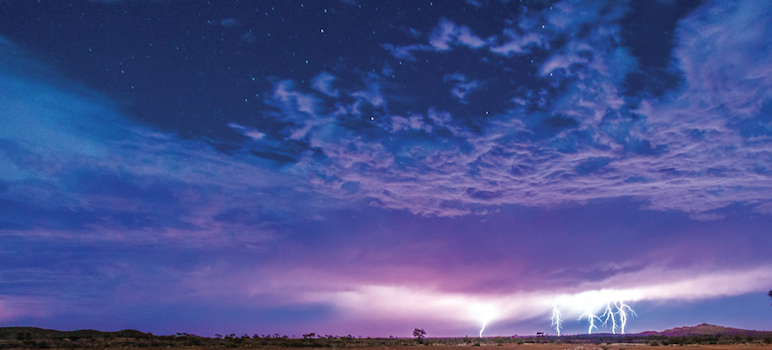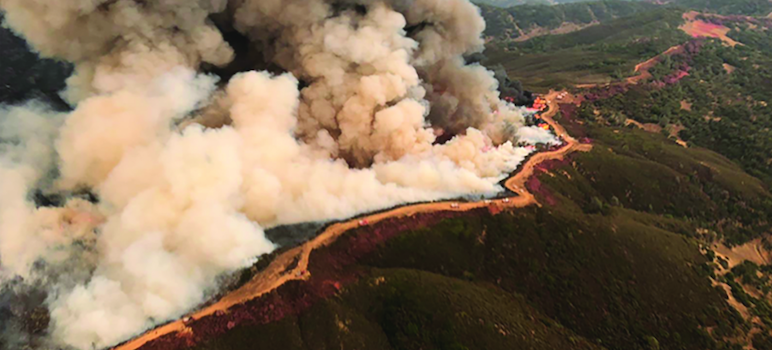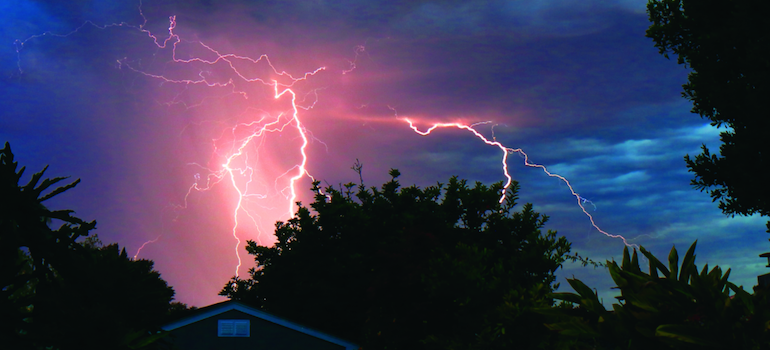On humid summer nights growing up in southeast Minnesota, when the air would turn still and the sky a shade of eerie green or black, I would often trek outside barefoot—bowl of cereal in hand—to watch the shifting winds and moving fronts along the horizon.
Dealing with extreme weather is just a way of life in the Midwest. Whether hearing a siren’s piercing wail warning of a nearby tornado, snowplows dragging their blades clearing ice built up along salty roadways or a ref’s whistle postponing outdoor soccer games to avoid humidity thick enough to cut with a knife, Mother Nature’s force was almost a comforting presence.
That daily dynamic ground to a halt after moving 2,000 miles west to the Mediterranean heart of Silicon Valley.
Nestled in between the lush green slopes of the Santa Cruz Mountains and the dry canyons and ridges stretching along the Diablo Range, the location of Santa Clara Valley’s 830,000 acres is key to its famed balmy temperatures and nearly perpetual sunshine, only 30 miles inland from the Pacific Ocean.
As the coast’s chilly stratus layer consistently washes up against the valley’s silhouette past Highway 280, evaporating before spilling over the hillside, and the peaks near Mt. Hamilton provide shelter from hot winds of San Joaquin to the east, blue skies have usually been a safe bet to forecast for the nearly two million residents spread from Milpitas to Morgan Hill, Saratoga to East San Jose.
Then August 2020 arrived.
My bare feet were elated to stand once more outside, tangibly feeling the weather from my Santa Clara apartment’s balcony. After taking in the shocking sight of hundreds of lightning strikes pummeling Santa Clara County, that feeling of “home” quickly took a turn, after a strobe of a bolt struck the ground just yards away from my perch. I hustled my whole kit and caboodle right back inside, shocked to see the ferocious power that’s possible when unpleasant weather finally made its way into the Valley of Heart’s Delight.
That freak storm gave way to hundreds of wildfires surrounding the valley, while smoke swirling with the quintessential Bay Area fog created the seemingly apocalyptic “Orange Day,” in the midst of a global pandemic. As a transplant in a newly strange land, all I could wonder was: has climate change “arrived” in the Bay Area, challenging the livability of this picturesque slice of California?
According to Alison Bridger, a meteorology and climate science professor at San Jose State University, that storm wasn’t entirely uncommon. A local for the past 30 years, she told me stories of how she’s seen storms of that scale rip through the South Bay roughly every five years.
“However, if there's a long term drought going on or if there's a long term drying associated with climate change, then the trees are drier and the undergrowth is drier and it's easier to start a wildfire with lightning,” she says. “That's where you suddenly jump up, look out the window and realize something different is happening.”
The climate that makes the Bay Area a salubrious paradise has now molded the Santa Clara Valley into an “island” of sorts; while so far able to shield its residents from some of the most extreme, direct events of climate change, the difference now is that the South Bay won’t remain impervious to California’s increasingly drier and hotter weather forever—raising the stakes for dangerous outcomes, if and when moments like August 2020 strike again.
Water Tables Turn
Latitude, altitude and proximity to the ocean are the three key factors climate scientists examine to understand the mechanics behind a region’s weather—or lack thereof. The South Bay’s triple threat, combined with its duel mountain ranges, has crafted microclimates desired around the world.
Air has one main entrance into the Santa Clara Valley: the Golden Gate Gap. Chilly zephyrs swiftly moving in from the Pacific Ocean’s coast are warmed and dried by the sun and ground, as the breezes sink into the valley’s sea-level atmosphere at Alviso, and ultimately exit to the south past the Coyote Valley Open Space Preserve.
Silicon Valley’s lack of moisture, combined with its rain shadow from the Santa Cruz mountains, means summer rain is an oxymoron. Winter skies are not tediously dreary or gray; the occasional shower or cloudy day resolves with clear blue skies, within days or even hours, and thunderstorms with lightning rarely reach necessary conditions. The area averages only 15 inches of annual rainfall—most common between November and March, unless pressure systems tap into atmospheric rivers—which help replenish water supplies within California’s reservoirs.
So, what extreme weather does capture the immenseness of climate change’s impacts? If scalding 120º temperatures, torrential rainfall or fever dreams of snow ever shuffle into San Jose, that’s when Bridger says more immediate concern should begin.
“I think maybe people don't think about [the weather here] all that much,” Bridger says. “They just get used to it, and then when we have something like last summer when the lightning storm came in … newly arrived people are going to wonder, ‘Oh my god, is this climate change?’ No, it isn’t.”

Lightning strikes along the horizon in this file photo.
However, weather events themselves may be less important to the narrative. Bridger says while those events rarely occur, climate change's minimization of water makes the conditions worse for when they do.
“I am not terribly worried about the Bay Area climate change in the next 30 years,” Bridger told me, with a tinge of hesitancy in her voice as she explained the potential for enormous disruption. “But even if it's not happening in the Bay Area, if you only have to go 100 miles to find it, then you're going to be impacted. Nobody's safe from climate change.
“I think the thing that worries me the most would be the amount of snowfall that happens in the Sierras every year—I think that's probably our biggest vulnerability.”
Valley of Shangri-La
This ain't no Land of 10,000 Lakes.
2021 marks the driest the Bay Area and the state has been during the past 126 seasons, and the southwestern United States as a whole is experiencing its driest 20-year span since the late 1500s’ megadrought.
Comforting only in the way that we’ve “survived this before,” I learned water has always been a tricky resource for Californians to manage.
By 1920, the valley’s intensive orchard farming and irrigation “irreversibly depleted the fresh water artesian basin beneath them, and the valley floor had begun to sink,” according to history professor Rebecca Conard. That led to the design of a system of reservoirs to store winter flood water in 1926, which the Santa Clara Valley Water Conservation District hoped would support both the area’s population and booming processing industry.
Fast forward nearly 100 years, and that proved to only be a temporary solution; seismic retrofits down-drew 30,360 acre-feet of water from the Anderson Reservoir since February 2020; as of July 1, Valley Water’s nine remaining local reservoirs are holding only a quarter of the 20-year average for this time of year.
Oh, and the Bay Area has reached the U.S. Drought Monitor’s most severe level.
Those rates are why Bob Bornstein, professor emeritus of SJSU’s meteorology and climate sciences department, also ranks water as his highest concern for climate change locally.
As a rule of thumb, he says global climate change scientists have concluded that the state of California will get hotter and drier. That means precipitation in the Sierra Nevadas mountains will change from snow to rain; even if the total water content doesn’t drop, the amount of water getting into our reservoirs will decrease as the amount of snow diminishes.
This is bad news.
Bornstein says Santa Clara County’s reservoirs are typically filled when water rushes down from the Sierra Nevadas at once, passing over then-soggy, saturated ground as the snowpack melts in the first months of summer.
However, if the peaks’ white powder is replaced by yearlong rain, the ground will greedily absorb more of that water as it falls, allowing fewer H²O droplets to be collected to drink. Unfortunately, San Jose has seen less than half of its usual rainfall so far this year.
“We are an island that will be shielded from the worst effects of climate change—except for water,” Bornstein explains. “Long term, that’s the biggest threat to the Bay Area and to California.”
There have also been less-than-fruitful attempts to increase the amount of snow that reaches mountain peaks.
I dug up old research papers detailing cloud seeding—a World War II-era attempt to spur precipitation in clouds using particles of silver iodide—experiments in Santa Clara County back to 1955, but the practice has since seen a resurgence. Million-dollar experiments still ongoing today initiated snow at cheaper rates than other alternatives, such as desalination, but not at any rate that could overcome drought.
Despite those struggles, Bornstein still thinks the South Bay’s current climate is reason enough for anybody to buy land here—if they can afford it. But he says the region actually has another trick up its sleeve: global warming has counterintuitively made its winters even milder and summer days cooler.
Bornstein’s team discovered a decade ago that as temps increase in the Central Valley, those bigger pressure systems will draw more cool, dense marine air inland from the coast, lowering Bay Area temperatures during summer days.
“We're not saying global warming isn’t occurring, but in special locations—such as the Bay Area—a reverse reaction sets in,” Bornstein says.
However, heat waves can and do penetrate the Santa Clara Valley from the east, meaning as that hot mountain air drops into the valley, it continues to warm—effectively blocking that cool, westerly breeze.
“Those are the worst wildfire conditions: hot, dry winds with high speeds is exactly what spreads wildfires in the summer,” he says, even if fires are burning outside the Santa Clara Valley, their impacts still reach our lives, lungs and living rooms. “Because it's so slow and relentless … it's harder to perceive climate change, and the human mind is not geared for long term planning.”
Borenstein says residents need to look ahead to how the intensity of heat waves, wildfires and droughts are getting worse—starting earlier and lasting longer—to grasp the immenseness of the issue.
“The wildfires may not be affecting the Santa Clara Valley, but they will be, and last year when the sky was red throughout the entire day, that was apocalyptic,” he said.“We are a valley of Shangri-La, and we are shielded somewhat, but as the world deteriorates, it will impact us.”

The SCU Lightning Complex fires raged along the Diablo Mountain Range during August 2020, in this fire photo.
‘Slurbanizing’ Paradise
What hasn’t yet deteriorated is that glorified vision of the southern San Francisco Bay.
Mary Bowden Carroll, a journalist and 10-year San Jose resident, recorded travelers waxing poetic about the Santa Clara Valley at the turn of the 20th century, quoting folks referring to the lush agricultural destination as “paradise” or the “Garden of Eden.” Even magnate John D. Rockefeller admired “a picture such as I have never seen” during an April visit.
“The days when it is not agreeable to be out of doors are few,” Carrol wrote in her 1903 publication, Leaves from a Society Reporter's Note-Book, “and no day is so stormy but that one may walk or drive about in passable comfort.”
Eventually, the South Bay’s weather turned fruitful, as the newly dubbed “Valley of Heart's Delight” boasted dizzying concentrations of orchards, flowering trees, and plants. Until the 1960s it was the largest fruit-growing and packing region in the world, with 39 canneries producing hundreds of tons of produce.
However, as the city of San Jose and its surrounding area began to boom, ultimately orchards were largely cleared from the valley’s floor in favor of buildings, neighborhoods and roadways to accommodate its growing population. Between 1945 and 1964, Santa Clara County lost an average of 17,000 acres of farmland annually—ultimately losing 269,000 acres within those 20 years.
Bornstein, who specifically studies how cities affect climate and vise-versa, says that continued development has warmed the valley. As cities are built, replacing the region’s orchards, grasses and trees with concrete and brick over time removed the sources of shade and methods of cooling by evaporation orchards once offered, creating urban heat islands.
Maybe former Santa Clara County Planning Director Karl Belser, who opposed that era’s urban sprawl was onto something when he said, “Perhaps the only use we will ever find for the hydrogen bomb will be to erase this great mistake from the face of the earth."
So, Now What?
This past July, unhealthy air quality alerts have started pinging my phone, sparked by an unusually early start to wildfire season—Cal Fire has already tallied more than 579,000 acres burned and 6,049 fire incidents—that will likely last two months longer than events in the 1970s, 95% of which is climate-driven.
Reading (and now writing) inescapable headlines about climate change and tales of extreme weather, my mind often ponders the risks and rewards of joining others in fleeing this Golden State for seemingly more hospitable grounds—maybe back to Minnesota, where the snow is cold and the waters of Lake Minnetonka are purifying.
But also maybe I’ll follow in the footsteps of folks like Bridger and Bornstein who are weathering the current climate. Or maybe I’ll listen to Alex Cortinas, a Castle Rock State Park staff member who returned to the forests after his home burned down in the wildfires around Big Basin. While explaining his positive outlook about the loss, his insight struck me: burning is a natural part of California’s history, from naturally sparked blazes to the cycle of fires indiginous communities would light in the fall, anticipating the rainy season and providing the chance to provide nutrients for new growth.
“My first thought was, ‘It’s not even your house, it’s the forests,’” Cortinas nonchalantly told me over the phone. “It sounds very 1800s, but I do find some humor in that. Plus, all of the pollution from the fires makes a magnificent sunset.”


I liked this short description of our climate, geography, history etc. Artfully written!
Santa Clara Valley’s weather HAS been strangely unaffected. We’re kind of in that sweet spot still getting the cooling influence of the cold Humboldt current but without cold persistent fog and wind like right on the coast. But it seems our summer heat gets delayed maybe a month and a half from what it used to be. Most of our hot spells now seem to be in September. October and even November.
But yeah, it’s depressing to look at the small muddy puddles that we call reservoirs. If you want a reminder of how most of the local reservoirs used to look go have a look at Calero.
It’s kept pretty full. Blue and inviting! Just like Almaden, Guadalupe, UVA’s, Lexington, Anderson, Chesbro, and Coyote used to be in mid summer.
Let’s hope this winter we get a series of those cold, powerful Gulf of Alaska spawned storms that used to come through so reliably.
Thank you, Katie, for your great article. I found it very interesting and informative. Best regards.
It’s interesting, could use some corrections and augmentation (most warming is in winter, so deciduous agriculture must worry about loss of chilling hours, for example), but overall, it’s interesting. Including the SJSU authoritative sources was a good decision. Note the concern isn’t the short-term, currently much over-hyped and over-sensationalized short-term phenomena, but that it is a decades-long process expected to bring warming and drying to (most of) the western US. (Southern California may anticipate loss of Colorado River water eventually, adding to the desire to send Sacramento River water around the Delta, then southward.) More work on surface observations as well as improving climate models, and review of paleoclimatic data, to analyze the eastern North Pacific High’s location and future shift north would be valuable.
No crazy hype material is in order. Yes, more paving and more conventional motor vehicles, too, means more heating. (So does cleaning the air, which admits more insolation, but cleaner air is to be welcomed.) More interesting is to speculate on those warmer winters that could even bring some reliably frost-free winter weather to the Bay Area, beginning with San Francisco and immediately adjacent parts of Oakland and the East Bay core and fanning outward from there — better living for humans, provided it remains possible to Just Add Water.
“Artfully written!”
Some smart features, too. Contrast her work with child past his forties Manjoo’s.
Balderdash.
In case anyone is interested, here is some actual lightning data:
https://www.vaisala.com/sites/default/files/documents/WEA-MET-Annual-Lightning-Report-2020-B212260EN-A.pdf
I didn’t post it earlier, but why not now. Here is her Valley, with its main Rampart.
https://cdn.shopify.com/s/files/1/0476/1265/7818/products/K-SF2225_b_1024x1024.png